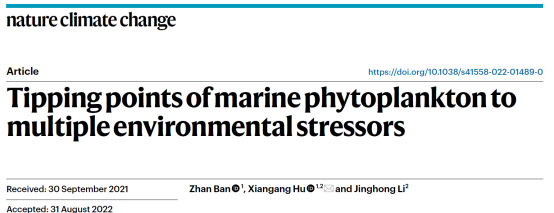NKU Team Established Relationship Between Marine Environmental Chemistry and Environmental Biological Effects Based on Artificial Intelligence
Recently, Professor Hu Xiangang, from Key Laboratory of Pollution Processes and Environmental Criteria of the Ministry of Education, College of Environmental Science and Engineering of Nankai University, and Academician Li Jinghong, from the Department of Chemical Engineering of Tsinghua University, revealed the key environmental factors affecting the abundance and productivity of marine phytoplankton based on the combination of big data on environmental chemistry with artificial intelligence technology (machine learning), and predicted the impact of different representative concentration pathways (RCPs) on the productivity of marine phytoplankton. The findings were published in the top academic journal Nature Climate Change under the title "Tipping points of marine phytoplankton to multiple environmental stressors".

Professor Hu Xiangang's team found that the impact of marine environment chemicals on phytoplankton may be in the form of a superposition of multiple factors or antagonism, which is often nonlinear. It is difficult to construct a complex relationship between the two using a conventional mathematical statistical model.
In view of this, the team predicted the impact of eight environmental chemical variables on the abundance and diversity of over 1,500 kinds of marine plankton by using a variety of machine learning models to mine the big data on marine environment chemicals. They verified the reliability of the model through the actual marine monitoring data, realized the stable migration of the model in time and space, and identified the sensitive areas and key constraints regarding the response of global marine phytoplankton to marine environmental chemicals. They found the possible tipping points of drastic changes in phytoplankton diversity caused by the marine environment's chemical conditions, providing a key reference for marine biodiversity conservation and the enhancement of carbon sink capacity of marine life.
"While temperature and carbon dioxide play a key role in affecting the environmental effects of marine phytoplankton, other marine environmental chemicals such as nitrates, phosphates, and silicates can not be overlooked. Tropical marine areas may be more sensitive to environmental chemical influences," said Hu Xiangang.
Ban Zhan, from the College of Environmental Science and Engineering of Nankai University, is the first author of the paper, and is responsible for the operation and verification of the model. Professor Hu Xiangang is the corresponding author. Professor Zhang Ying and Dr. Zhou Baohang, from the College of Computer Science of Nankai University, provided technical support for the improvement of the model and algorithm. Professor Zhou Qixing from the College of Environmental Science and Engineering of Nankai University provided guidance and support for the research.
Link to the paper: https://www.nature.com/articles/s41558-022-01489-0
(Edited and translated by Nankai News Team)









